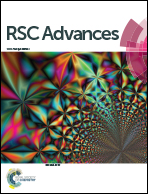DOX sensitized upconversion metal–organic frameworks for the pH responsive release and real-time detection of doxorubicin hydrochloride†
Abstract
Drug resistance is a major obstacle in cancer treatment, and designing a material that monitors real-time drug release remains a top priority. In this study, metal–organic frameworks doped with lanthanum and thulium were synthesized and then coated with aminated silica to form La/Tm-MOF@d-SiO2 as a drug carrier. Doxorubicin hydrochloride (DOX) was selected as a drug model, and the drug loading and release were investigated. It was found that the release of DOX under acidic conditions reached an optimal level, indicating the pH-responsiveness of La/Tm-MOF@d-SiO2. Under acidic conditions (pH = 5.8), upconversion fluorescence was generated after loading DOX on La/Tm-MOF@d-SiO2. At pH = 5.8, the longer the drug released, the stronger the upconversion fluorescence. It was found that the upconversion fluorescence intensity is directly proportional to the amount of drug released; thus, the real-time monitoring of DOX release in tumor cells can be performed based on the upconversion fluorescence.



 Please wait while we load your content...
Please wait while we load your content...